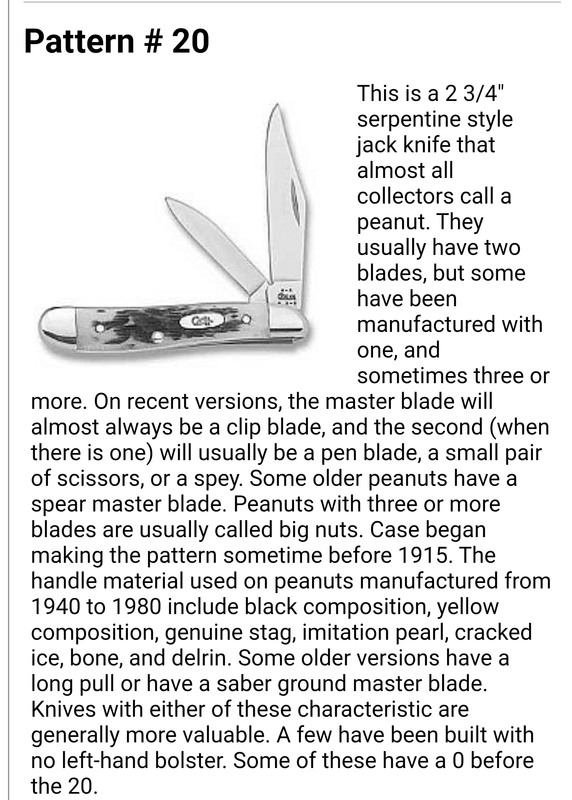-
The BladeForums.com 2024 Traditional Knife is available! Price is $250 ea (shipped within CONUS).
Order here: https://www.bladeforums.com/help/2024-traditional/
You are using an out of date browser. It may not display this or other websites correctly.
You should upgrade or use an alternative browser.
You should upgrade or use an alternative browser.
Case peanut 3220cv
- Thread starter Hjalmar69
- Start date
- Joined
- May 16, 2009
- Messages
- 1,088
I am gonna guess since the 60s…but I am just guessing.
paulhilborn
Gold Member
- Joined
- Mar 22, 2006
- Messages
- 14,483
From the 40's on with yellow composition/delrin thoughWhy guess, when the AAPK source I posted said "some time before 1915"?

- Joined
- Apr 12, 2009
- Messages
- 13,498
I have a 3220 from the 1950-1964 era. That would be the latter part of the 'CASE XX' era, post-1950, during which time they began including the pattern stamp on blades.
This knife might be as old as I am (60) or maybe older. But it looks in much, much better shape than I am these days. Pristine old pocketknives might be ageless. Me, not so much.




This knife might be as old as I am (60) or maybe older. But it looks in much, much better shape than I am these days. Pristine old pocketknives might be ageless. Me, not so much.




Last edited:
- Joined
- Apr 12, 2009
- Messages
- 13,498
With 'delrin' specifically, Case didn't start using that in any form or color until 1967. Coincided with their release of the original 2138 Sod Buster in black Delrin.For how long has this pattern been around with yellow delrin scales?
Really curious since it is one of my top three favorite pocket knives.
Anything prior to 1967 would've been some other synthetic material, otherwise called 'composition'.
Edited to add:
With regards to the 'CV' designation, I don't think Case started including 'CV' in the pattern names or pattern# stamp until the 1990s or so. Anything in plain carbon steel, prior to then, was only stamped with the base pattern#. And stainless patterns were always stamped either 'SS' or 'STAINLESS'.
Last edited:
Modoc ED
Gold Member
- Joined
- Mar 28, 2010
- Messages
- 14,379
Here's a current thread on the Case Peanut that has all the info you could possibly want to know - 259 pages about it.
 www.bladeforums.com
www.bladeforums.com
Cult of the peanut , members
Last night it hit me. I've been changing my edc knife for the past months, choosing only from my traditional knives, but still resorting to some fixed blade or larger folder when i went in the woods. That's where the peanut is not enough, at least for me. But concerning the rest, the peanut does...
 www.bladeforums.com
www.bladeforums.com
Makes sense to not marking carbon anything when it was the normWith 'delrin' specifically, Case didn't start using that in any form or color until 1967. Coincided with their release of the original 2138 Sod Buster in black Delrin.
Anything prior to 1967 would've been some other synthetic material, otherwise called 'composition'.
Edited to add:
With regards to the 'CV' designation, I don't think Case started including 'CV' in the pattern names or pattern# stamp until the 1990s or so. Anything in plain carbon steel, prior to then, was only stamped with the base pattern#. And stainless patterns were always stamped either 'SS' or 'STAINLESS'.
- Joined
- Apr 12, 2009
- Messages
- 13,498
A reference guide I look at lists a 'Tested' era (pre-1940) 3220 in yellow composition. But no more specifics about how much earlier than the 1940 reference point. Might've been 1939 or so, maybe in transition to the otherwised assumed & accepted '1940 and later' ballpark. Case has had some 'transition' overlaps like that before, leaving the exact beginning of certain pattern incarnations kind of vague sometimes.
Hickory n steel
Gold Member
- Joined
- Feb 11, 2016
- Messages
- 20,730
I really want to love the Case peanut and I sort of do, but I just can't find a proper example in good enough condition for a reasonable price.I have a 3220 from the 1950-1964 era. That would be the latter part of the 'CASE XX' era, post-1950, during which time they began including the pattern stamp on blades.
This knife might be as old as I am (60) or maybe older. But it looks in much, much better shape than I am these days. Pristine old pocketknives might be ageless. Me, not so much.

I bought a new 3220 not even thinking about it, but I just cannot get past the nail nick position on the current examples.
It makes the knife look like it has a sharp peak on the spine, and it reminds me of a cheap Pakistani Frost Cutlery from the flea market.
Modoc ED
Gold Member
- Joined
- Mar 28, 2010
- Messages
- 14,379
It may or may not be interesting to some of you that Case is a "want-not waste-not" company. If they have blades left over at the end of the calendar year, they will use them into the next year until they are used up. I know this is a thread about the Peanut but here is an example of what I'm talking about.
I ordered this Sod Buster Jr. on August 2, 2021 and the box label indicates it was made on 01/29/21 yet the knife that came in the box has the 10-dot 2020 tang stamp. An example of carrying a previous year's blade into a new year.

This is one reason why it is difficult to say with absolute certainty when a knife was made or what feature was introduced in an exact time frame.
There are some excellent books out about Case Knives. Some of you might give some thought to ordering one or two.
Edited to correct ordering date.
I ordered this Sod Buster Jr. on August 2, 2021 and the box label indicates it was made on 01/29/21 yet the knife that came in the box has the 10-dot 2020 tang stamp. An example of carrying a previous year's blade into a new year.

This is one reason why it is difficult to say with absolute certainty when a knife was made or what feature was introduced in an exact time frame.
There are some excellent books out about Case Knives. Some of you might give some thought to ordering one or two.
Edited to correct ordering date.
Last edited:
- Joined
- Apr 12, 2009
- Messages
- 13,498
Along the same lines as mentioned by Ed above, I have a 6265 SAB Folding Hunter with a blade date-stamped from the 1965-'69 era. This is sometimes called the 'U.S.A.' era, as that's when Case started stamping 'U.S.A.' on their blades. Even with the '65-'69 stamp on the blade, the frame itself is the slightly different handle pattern carried over from the 'XX' era (1940-'64) Folding Hunter, with a deeper finger grip indent just aft of the pivot-end bolster. It's known as the 'XX-era' frame for that pattern. So, it bridges the transition between those two eras in Case's history, which I think is kind of cool and also more likely pins down it's time of manufacture to very early in the 'U.S.A. era' period, probably in 1965.




How large is that fine knife?Along the same lines as mentioned by Ed above, I have a 6265 SAB Folding Hunter with a blade date-stamped from the 1965-'69 era. This is sometimes called the 'U.S.A.' era, as that's when Case started stamping 'U.S.A.' on their blades. Even with the '65-'69 stamp on the blade, the frame itself is the slightly different handle pattern carried over from the 'XX' era (1940-'64) Folding Hunter, with a deeper finger grip indent just aft of the pivot-end bolster. It's known as the 'XX-era' frame for that pattern. So, it bridges the transition between those two eras in Case's history, which I think is kind of cool and also more likely pins down it's time of manufacture to very early in the 'U.S.A. era' period, probably in 1965.


- Joined
- Apr 12, 2009
- Messages
- 13,498
As compared to the Peanut, it's a BEAST.How large is that fine knife?
5-1/4" closed, and about 9-1/8" overall with the main clip blade opened.
- Joined
- Apr 12, 2009
- Messages
- 13,498
I'd not even noticed the more central location of the nail nick on the current version, as compared to the older ones with the nick aft of the peak.I really want to love the Case peanut and I sort of do, but I just can't find a proper example in good enough condition for a reasonable price.
I bought a new 3220 not even thinking about it, but I just cannot get past the nail nick position on the current examples.
It makes the knife look like it has a sharp peak on the spine, and it reminds me of a cheap Pakistani Frost Cutlery from the flea market.
I'm guessing at this. But, I suspect maybe Case moved the nick forward a bit, to compensate for the sometimes stiff pull on these tiny blades. Peanuts are known to kind of snappy, and the small & shallow nail nicks sometimes let the blade get away from one's hold when opening or closing. It's made all the worse with a shallow nail nick on a very thin blade. Makers sometimes move the nick forward, to better leverage the blade on knives with stiff pulls. That's the only logical reason I could see, for positioning it the way they did.
WowAs compared to the Peanut, it's a BEAST.
5-1/4" closed, and about 9-1/8" overall with the main clip blade opened.

